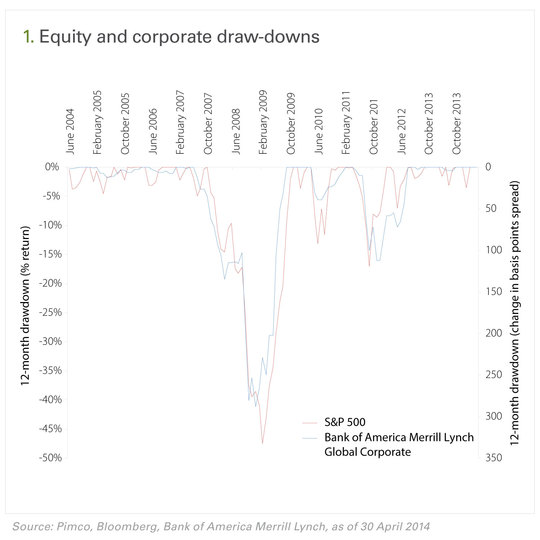
This article was paid for by a contributing third party.More Information.

Tail-risk hedging – Improving the return on capital

The European Union’s Solvency II directive has required insurers to give even greater consideration to the capital they hold and the way in which they deploy it. In this sponsored feature, PIMCO experts Eugene Dimitriou, senior vice president, financial institutions group, and Jeroen van Bezooijen, head of Europe, Middle-East and Africa investment solutions, discuss the benefits of a holistic approach to tail-risk hedging and demonstrate how cost-effective hedging can improve returns on capital.
Quantification and management of tail-risk events remain at the core of the insurance industry. Extreme events, such as floods and storms – but also market crashes – can erode capital and profitability and, thus, contribute to the challenge faced by insurers to meet and exceed promises to policy-holders.
Insurance regulators recognise this, and the capital requirements under Solvency II (SCR) will be based on potential losses in extreme situations (99.5% value-at-risk (VaR)). The SCR draws together disparate risks across the balance sheet and seeks to reflect the correlations between these risks in a single capital requirement. This is to ensure insurers will be able to meet their respective obligations over a 12-month period (with a probability of at least 99.5%). As a result, insurers are increasingly centralising risk management and hedging decisions. This positive step encourages insurers to focus on meaningful tail risks across the consolidated insurance group in a consistent and holistic manner.
Tail-risk hedging at reasonable costs
We believe insurers need to address two key issues: how to best manage portfolio tail risks; and whether such tail risks can be reduced effectively at a reasonable cost.
The cost of hedging can be reduced by sourcing cheap tail hedges. PIMCO research shows mechanistically rolling direct hedges, such as buying Euro Stoxx or S&P 500 index puts every year and rolling at expiry, is generally expensive. However, in tail events, correlations between risk markets increase. When equities sell off significantly, credit spreads widen and carry trades, for example, long Australian dollar and short Japanese yen, typically sell off. An indirect hedge, such as buying credit protection or an Australian dollar/Japanese yen put, can be a less costly, but effective, alternative hedge to an equity put. In addition, option markets show strong mean-reverting behaviour, monetising gains after option prices have increased. This also reduces the cost of hedging over time.
Neither tail-risk hedging, nor the use of options is new to insurers. Many general insurers have a re-insurance strategy in place to reduce the impact of insurance tail events, such as extreme weather incidents. Although many life insurers use options and other derivatives to hedge embedded return guarantees, we see few insurers employ option strategies to reduce (financial) tail risks at the balance-sheet level.
To illustrate the benefits of tail-risk hedging, we have analysed a typical European insurance company that tends to invest 85% of its assets in fixed income, with the remainder allocated to equities, real estate and alternatives. The fixed-income portion of the portfolio is mainly invested in government bonds and high-quality corporate bonds, but also in covered bonds, securitised assets, high-yield and emerging market debt. In our example, we assume the insurer has closely matched its liabilities with its fixed-income allocation. We then look to answer two questions:
- How do we best hedge the tail risks of this portfolio?
- How does this impact the insurer’s return on capital?
How to hedge tail risks
It is not feasible to hedge every security precisely, nor is it possible to buy precise hedges on every asset class or benchmark. PIMCO uses a risk factor approach instead, whereby we identify and hedge the main drivers of risk. For the assumed portfolio, we determined that more than 80% of the risk is driven by equity and credit spread risk. This may seem surprising given the relatively small size of the equity allocation. Equity is far more volatile than fixed income, however, and the bonds match the liabilities – so only the credit spread component contributes to risk.
Based on our risk analysis, we conclude equity puts are the most direct and effective hedges for such a portfolio. While this is obviously the case for the equity risk, it is also true for the credit component, for two reasons. Firstly, there is no liquid market in puts on corporate bonds or corporate bond indexes. There are puts and other derivatives on credit default swap indexes, but liquidity is generally poor for longer-option maturities and basis risk is meaningful. Secondly, in tail events, the correlation between bond and equity markets increases dramatically, making equity puts an effective hedge for tail risk in corporate bonds (figure 1).

As such, our preferred approach is to implement an actively managed option portfolio to manage tail risks. This portfolio would be anchored on equity index puts but actively managed, including the use of indirect hedges.
How tail-risk hedging impacts the return on capital
By focusing our analysis on the return on capital, we are able to examine both the impact on return and the downside risk, which we use as a proxy for required capital. We achieve this by modelling an insurer’s portfolio, both with and without tail-risk hedging. We employ PIMCO’s risk factor model to project portfolio returns under different scenarios, using a ‘block-bootstrapping’ approach (that is, re-sampling of blocks of historical data). The expected returns of the various asset classes are based on PIMCO’s forward-looking capital market assumptions.
The impact of tail-risk hedging depends on the historical period chosen for the sampling. Tail-risk strategies, for example, look extremely attractive over the past 10 years as this includes the 2007–2009 global financial crisis, which saw bumper payoffs for tail-risk hedges. If, on the other hand, we focus only on the past five years, when no real tail events occurred, tail-risk strategies would be less appealing.
Despite this, we find that for most periods and sampling methods tail-risk hedging – using direct and indirect hedges – improves the return on capital. This is because any drag on return is more than offset by a reduction in downside risk/required capital. For an optimised tail-risk portfolio consisting of equity and currency puts, for example, the return on capital improves from about 10% to 16%, as the required capital – approximated by 99% conditional VaR – is reduced from approximately 10% to around 4%. For the purpose of this analysis, we conservatively sampled only from periods where option prices were at similar levels to today’s prices.
We believe there are clear benefits, such as potential increases in return on equity. The new Solvency II regulations specifically consider hedging as a tool for capital management and explicitly identify some commonly used instruments such as swaps, swaptions, credit derivatives and puts.
In our analysis, we based capital requirements on the downside risk measured by PIMCO’s risk factor model, which is comparable to an internal model approach under Solvency II. When using the standard model, a key requirement for effective hedging is the ability to demonstrate “the risk-mitigation technique will mirror at least 90% of the change in value of the risk exposure of the insurance or reinsurance undertaking”. However, guidance on how to compute this correlation is limited and implicitly left to local regulators to interpret. Many hedges exhibit high correlations in most, but not all, historical data analysis – especially in the tails – or most, but not all, theoretical scenarios. A purist, however, might say this is not good enough.
As a practical matter, regulators must tolerate some level of basis risk as they recognise that perfect hedges are often uneconomical or simply unavailable in the market. This is important as most hedges naturally have some degree of mismatch with the underlying portfolio, for instance:
- the use of euro-denominated hedging instruments to cover Danish krone;
- the use of index-based hedges – such as the FTSE 100 or Euro Stoxx – to protect an actual portfolio of equities;
- simplified batching of interest rate exposures, for example, the use of various key rate durations on a swap curve; or
- the use of pure capital market instruments, such as swaps or swaptions, to hedge liabilities, which combine capital markets characteristics with biometric risk such as lapse or longevity.
Local European regulators may come to different conclusions on a case-by-case basis, but it appears likely that some degree of basis risk must continue to be acceptable, especially if the intention is genuine tail risk management across an insurance group.
Our analysis, therefore, suggests it makes sense for insurers to consider tail-risk hedging of financial risks. In addition to the return on capital argument, it may also make sense from a market perspective, given the cost of equity options is currently low in a historical context, at a time when equity and credit markets have performed strongly. The ability for access protection, which appears inexpensive from a historical perspective, combined with the ability to redeploy capital may provide a compelling argument for all insurers.
Download/read the article in PDF format
Sponsored content
Copyright Infopro Digital Limited. All rights reserved.
As outlined in our terms and conditions, https://www.infopro-digital.com/terms-and-conditions/subscriptions/ (point 2.4), printing is limited to a single copy.
If you would like to purchase additional rights please email info@risk.net
Copyright Infopro Digital Limited. All rights reserved.
You may share this content using our article tools. As outlined in our terms and conditions, https://www.infopro-digital.com/terms-and-conditions/subscriptions/ (clause 2.4), an Authorised User may only make one copy of the materials for their own personal use. You must also comply with the restrictions in clause 2.5.
If you would like to purchase additional rights please email info@risk.net